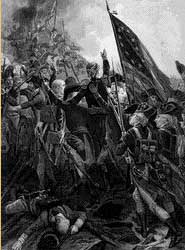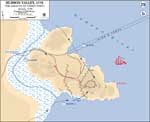Colonial Wars |
American Wars |
Link To This Page — Contact Us —
The Battle of Stoney Point
July 16, 1779 at Stony Point, New York
 |
|||||||||||||||||||||
|
Stony Point has a rocky promontory and wooded faces, it rose 150 feet at its highest point and it projected out into the Hudson River for more than 1/2 mile. The westerly, or inland slope, dropped off into a marsh. King's Ferry landing was at the north side and was submerged in deep water. The south side was also covered with water. The British fortified Stoney Point with 7 or 8 detached batteries on the uneven summit and converted the west end rock formation into a strong bastion. They had also cut down all the surrounding woods and used the felled trees to construct 2 rows of abatis from water to water across the point.
To protect the main British garrison stationed in New York City and dissuade Gen. George Washington from moving his army down the Hudson River from his encampment at West Point, Lt. Gen. Henry Clinton established and maintained an outer network of defenses. An integral part of this defensive network included several strongholds along the river. Two of the strongest were at Stoney Point, 24 miles north of New York City, and Fort Lafayette on Verplank's Point.
The gunboat, HMS Vulture, cover both of the forts from the water. Verplank's Point, across the river, could be signaled by rocket for reinforcements.
Stony Point had a 625-man garrison, commanded by Lt. Col. Henry Johnson. Its defenses consisted of two landside lines and outposts protected by obstructions that made an approach from the west difficult. The outer line had 300 men and 7 guns and the inner line had 300 men and 6 guns. Johnson felt certain that his defenses were secure. The British had established control of this region and had nicknamed Stony Point its "little Gibraltar."
Washington responded to Clinton's move by marching his troops north from Middlebrook, New Jersey, to protect the American fortifications at West Point. Clinton garrisoned Stony Point and Verplank's Point with about 1,000 men to protect the King's Ferry, which crossed the Hudson River between the two points. He then launched raids against Connecticut coastal towns, in the continuing attempt to lure Washington into battle. Clearly, the British could not be allowed to remain unopposed at Stony Point.
On June 15, Washington had ordered militia Capt. Allen McLane to gather information on the British strength at Stoney Point. Two weeks later, McLane entered the place disguised as a local female farmer. He told the British guards that she was visiting her sons, presumably Tories serving with the British, inside the fort. He found out that the works were still unfinished and vulnerable. he also conducted further reconnaissance on the outside of the fort.
On July 2 , Washington observed the British works himself from nearby Buckberg Mountain and devised a plan. Brig. Gen. Anthony Wayne would lead a surprise midnight assault against Stony Point. Wayne considered this surprise attack as a revenge for the Battle of Paloi (Massacre) a couple of years earlier. He commanded the Corps of Light Infantry, a select force which probed British lines, fought running skirmishes, and defended the army against sudden attack. The Light Infantry was comprised of the very best soldiers, each regiment producing 1 company, which then served on detached duty.
On July 15, Wayne's troops began their 15-mile march from Fort Montgomery. For 8 hours, they struggled over narrow mountain trails, arresting civilians they encountered en route to avoid detection. Washington had monitored Stony Point for several weeks. Several spies had, under a ruse, entered the fort and took note of its armaments.
The main assault would be delivered in 2 prongs, one from the north and the other from the south. Both would have to cross the muddy tidal flat marshes at low tide to reach the British defenses. Because the main attack would be delivered by the southern thrust, Wayne traveled with that column, which consisted of 700 men. They would strike just above the shoreline near Haverstraw Bay. The northern column of 300 men was led by Col. Richard Butler. Each column was spearheaded by a Forlorn Hope- 20 men armed with nothing but axes to chop their way through the abatis. On their heels was an advance party of 150 riflemen, who in turn would be followed by the main body.
Wayne's plan was to be a 3-prong attack:
- The smallest force, commanded by Maj. Hardy Murfee, would attack first. They would fire their muskets to create a diversion sufficient to convince the British that the main attack was being delivered up the middle.
- A silent approach would be made from the south, across the sunken sandbar at Haverstraw Bay. This would compose the largest body of troops, led by Wayne.
- A second silent approach would occur concurrently from the north, across the bridge at King's Ferry.The two silent approaches would only use fixed bayonets and pikes. All of their muskets would be unloaded, making sure that an accidental discharge would not happen. The musket fire from the first force would be the signal for the two silent maneuvers to start their approach. They would also wear pieces of white paper in their hats to avoid confusion in the darkness and to be used for visual recognition. Finally, 24 artillerymen would accompany the Light Infantry, so that captured British artillery could be turned against the British gunboat and their other fort at Verplank's Point.
At 8:00 P.M., the entire force was gathered at Springsteel's Farm and waited. The farm was less than 2 miles west of the outer line at Stony Point. The troops were briefed about their mission for the first time. Wayne divided his command into two columns for the approach march.
At 11:00 P.M., all the troops were briefed and began the march to Stony Point. When Wayne drew near the outer line of obstructions, Murfee broke off with his men and formed the center column, halted opposite the center of the British outer line, and formed up for the battle.
On July 16, between 12:15-12:30 A.M., British sentries signaled that something was amiss by firing at dark figures moving on either end of their outer line of obstacles. Within a few minutes of this, the Forlorn Hope chopped their way through and rushed toward the inner line of obstructions without firing a shot. The confused British sentries were still trying to figure out what was going on when Murfee's center column opened fire. The British troops immediately returned fire. Johnson rushed forward to organize his men and to focus the efforts against Murfee's demonstration. He then formed 6 companies, and moved them forward down the hill to strengthen their center.
Wayne was grazed by a bullet across his forehead but remained in control of the assault. Both American wings breached the British abatis and poured into their perspective assault areas. Lt. Col. Francois de Fluery was the first man to breach the British lines. Johnson realized the desperation of his situation and that an organized defense was no longer possible. The close-quarter fight inside the British works lasted for about 15 minutes. The British garrison was now forced to surrender. A British soldier managed to escape, swim out into the Hudson River to the Vulture, and warn it about the surrender. The Vulture promptly moved downriver to avoid the fort's American-controlled artillery.
The British at Verplank's Point and on the Vulture, when hearing the gunfire stop at Stony Point, shot into the air to congratulate their comrades on what they were sure was a British victory.
The barrage was less than one hour and was conclusive evidence to them that the British at Stony Point had succeeded in repelling the American offensive. After establishing control of the site, an American artillery detachment used the guns of Stony Point to bombard Verplanck's Point.
The American victory at Stony Point was the last major battle in the North, and also boosted American morale. Clinton's plan to defeat the Continentals and end the war had failed. Three days later, Washington abandoned Stony Point because he could not spare the men to continue to occupy the fort. He also knew it could not be defended against the combined might of the British army and navy.

